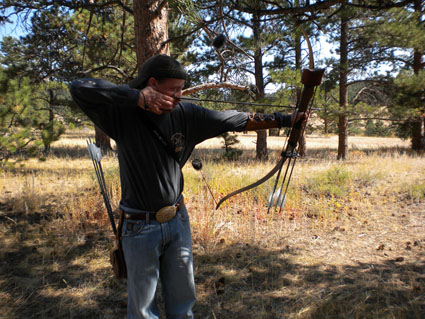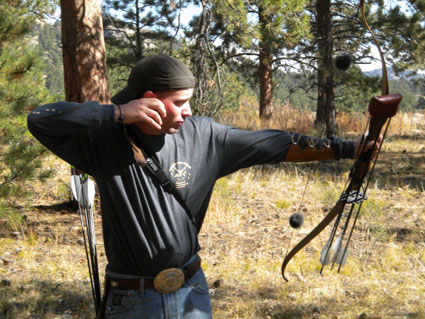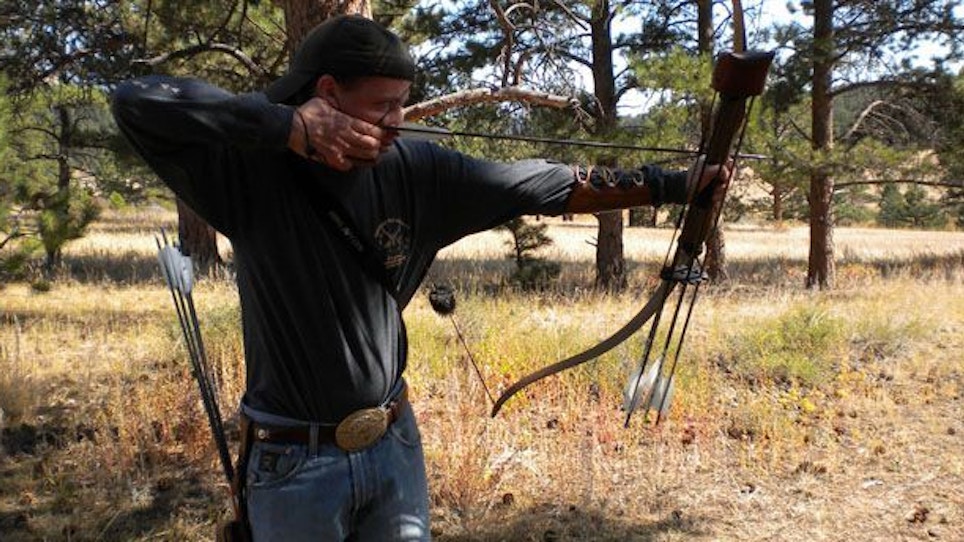 Shooting
Shooting
Start shooting from close range with a very small target and a very large backstop, which will save arrows and help you learn the most important elements in instinctive shooting — concentration and self-assurance.
The way you draw the bow should be consistent and should enhance accuracy. There are several methods. You may start with your bow arm straight and pointed toward the target, in about the right shooting position as you pull back with your string hand. Or you can use the push-pull method, in which your arms are held in front of the body and move in opposite directions into shooting position.
I use the straight-arm method, for two reasons. There is much less motion for an animal to see (in fact, an extended bow and bow arm will hide most of the movement of the drawing arm) and it allows me to start “aiming” even before I begin to draw.
As you draw, everything should seem to line up naturally. The bow should seem to naturally cant so that the arrow lines up under your eye. You might bend forward a bit, maybe bend at the knees. You can lean your head forward, but should avoid leaning too far ahead. It’ll shorten your draw and make it harder to line up everything.
Any experienced archer knows that a firm and consistent anchor point is important. It’s especially so with recurves and longbows, compared to compounds, because any variation in draw length will cause a greater variation in the energy transferred to the arrow, which translates to poor accuracy.
Most instinctive shooters have better luck with a fairly high and deep anchor point. Anchoring so the nock is just under the cheekbone is a good method. If you anchor as far back as you can while still being comfortable, you’ll get the most energy out of your bow without affecting accuracy.
Even before you reach your anchor point, you should be “aiming.” This consists of focusing both your eyesight and your bow muscles on a pinpoint that you want to hit. You aim the same way you aim to throw a baseball. Don’t try to guess yardage, and don’t try to “cheat” by looking at your bow or arrow.
 How quickly should you draw and release? Some archers snap-shoot, releasing, it seems, even before they’ve reached their anchor. Others draw and hold for several seconds, the way sight-shooters do. Most get best results by getting into a shooting rhythm in which they draw, hesitate for a consistent amount of time (usually a second or two) and then release. The hesitation gives you a moment to be sure you are focused on the target and everything feels right. Hesitating too long can get you thinking too much about the shot and second-guessing yourself, which tends to hurt accuracy.
How quickly should you draw and release? Some archers snap-shoot, releasing, it seems, even before they’ve reached their anchor. Others draw and hold for several seconds, the way sight-shooters do. Most get best results by getting into a shooting rhythm in which they draw, hesitate for a consistent amount of time (usually a second or two) and then release. The hesitation gives you a moment to be sure you are focused on the target and everything feels right. Hesitating too long can get you thinking too much about the shot and second-guessing yourself, which tends to hurt accuracy.
The release is related to the anchor point. A good release is basically one that does not change your anchor just as you shoot. You don’t let the string creep forward and you don’t pluck it, move it down or pull it away from your face.
A good release is best accomplished by back tension. Both hands and arms should be fairly relaxed; the work should be done by the back muscles. This keeps everything in line and consistent.
The actual release should be accomplished by just a slight, subconscious relaxing of the fingers on the string, while maintaining finger and back tension. Do not consciously open the hand.
Done properly, your string hand should jerk straight back a few inches upon the release. If it doesn’t, it means you aren’t using proper back tension, or that you are trying to change your muscle tension at the release, which will lead to inconsistency.
As your string hand jerks back, everything else should stay the same. Try to keep your bow and bow hand in the same position as it was before the shot. Don’t move your body. Don’t blink, and keep looking at the spot you want to hit until the arrow gets there. This is called follow-through, and a good follow-through is all-important. It can even counteract minor mistakes.
As you practice these fundamentals, remember that instinctive shooting is much more mental than it is physical. That’s one of my favorite facets of the game — the idea that boldness, confidence and determination play such major roles in success; that your attitude can actually make arrows fly true. Go in with the resolve that you will become a skillful instinctive shooter that you will make the shot, and you will.






